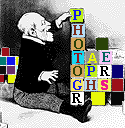 Baseball in a Vacant Lot
Baseball in a Vacant Lot
 Children on Webster Avenue
Children on Webster Avenue
 Demolition Worker
Demolition Worker
 Gilmore Way
Gilmore Way
 Lunch Counter
Lunch Counter
 "Stockyard--That's My Name"
"Stockyard--That's My Name"
 Two Young Girls
Two Young Girls
Richard Saunders was born in 1922 and became interested in photography while growing up in his birthplace of Bermuda. A local photographer whom he used to follow around gave him some old equipment to experiment with. When he was eight years of age, Richard Saunders and his family moved to the United States, where he put his early training to use while still in school. At the start of World War II, the family returned to Bermuda where he worked as a photographer with the police department. During the 1940s, Saunders returned to the U.S. and took up photography training at Brooklyn College and the New School for Social Research in New York City. Through his friendship with Gordon Parks, he acquired a job as a photographic lab technician, which enabled him to study and learn the techniques of the top photojournalists at Life magazine.
In 1950, Saunders was asked by Roy Stryker to join his team of top photojournalists in Pittsburgh to document the city's transition from a smoky milltown to a modern city. Saunders spent nearly two years there, living in the Hill District, where he "became part of the environment" and took four to five thousand photographs of the community.
For the next eleven years, Saunders went on to accept assignments for top publications such as Ladies Home Journal, Fortune, Ebony and Look, among others. In addition, he travelled to Latin America to document the Alliance for Progress, an economic development program sponsored by the U.S. government through the United States Information Agency. In 1967, Saunders accepted a staff position with the USIA's magazine for Africa, Topic, and was based in Tunis, from where he travelled throughout Africa photographing events, leaders and ordinary people. Transferred in 1972 to Topic's office in Washington, D.C., Saunders continued to travel and photograph in Africa until his retirement in 1986. In addition to publication of his photographs in magazines, Saunders has exhibited his work in group and one-person shows. He was also affiliated with Black Star Publishing Company.
Sources: An Illustrated Bio-Bibliography of Black Photographers, 1940-1988 by Deborah Willis-Thomas (1989), and A Century of Black Photographers, 1840-1960 by V.H. Coar (1983).
Baseball in a Vacant Lot
Children on Webster Avenue
Demolition Worker
Gilmore Way
Lunch Counter
"Stockyard--That's My Name"
Two Young Girls
pd
